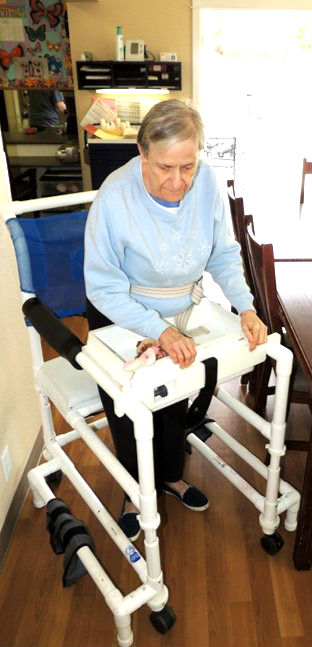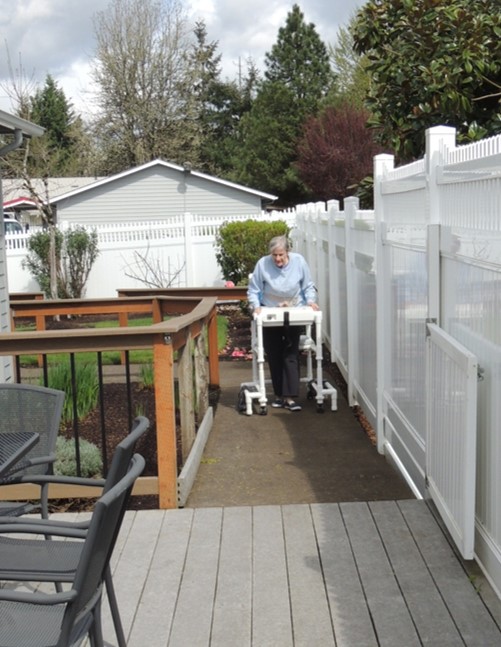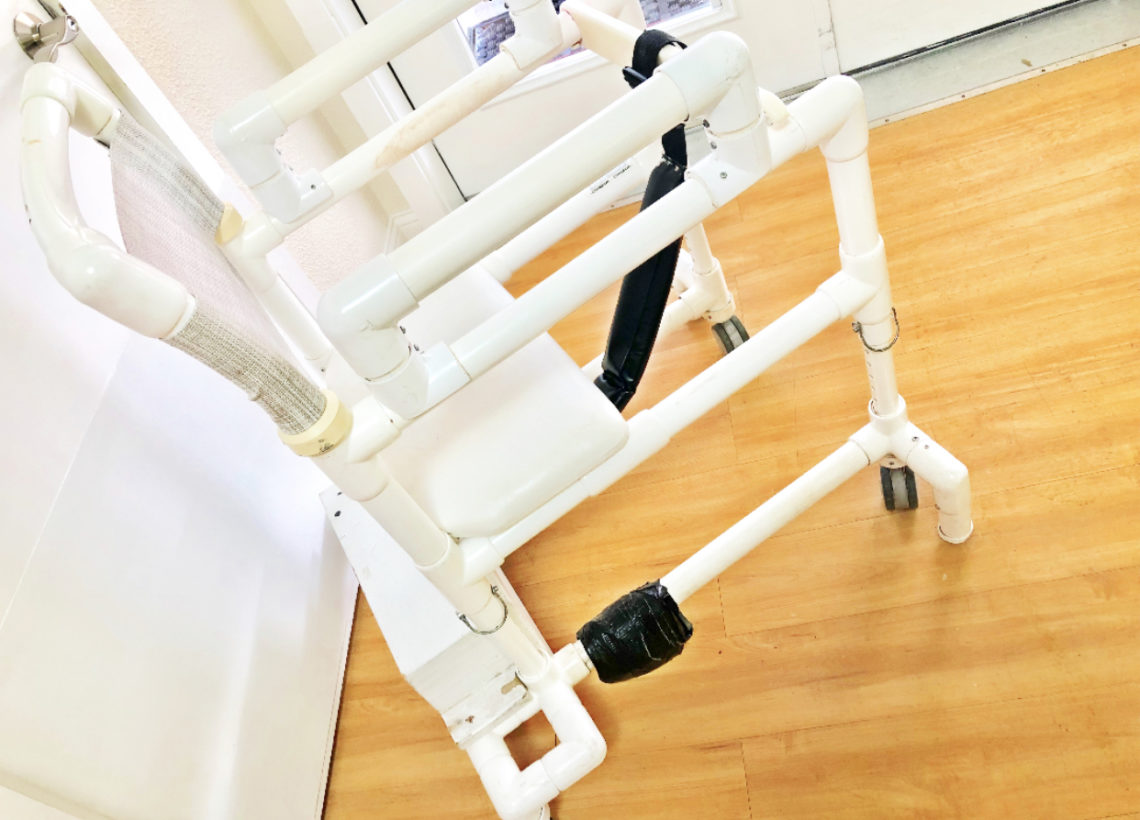
Liz von Wellsheim, MA, MSN, GNP
- What is a Merry Walker?
- When are they useful?
- Who benefits most from the use of a Merry Walker?
- Are they restraints?
- Are they for staff convenience?
- Who does NOT benefit from a Merry Walker?
- What to think about when prescribing or recommending a Merry Walker
- Conclusion
For the past 13 years I have been one of the owners of ElderHealth & Living Memory Village (EHL). I am a Geriatric Nurse Practitioner providing onsite medical management of persons with moderate to advanced forms of dementia. I have found that the introduction of a Merry Walker, to a patient with dementia who is starting to lose their ability to walk or recovering from a hip fracture, has been the best adaptive equipment I can prescribe to enable patients to WALK INDEPENDENTLY.
What is a Merry Walker?

A Merry Walker is a type of adaptive equipment. Adaptive equipment is equipment utilized to help with a physical or cognitive impairment. Walkers, wheelchairs, hearing aids or glasses are considered adaptive equipment which allow persons with a disability to function at their fullest. As a Health Care Practitioner in search of adaptive equipment to facilitate the achievement of personal mobility goals, a Merry Walker can be perfect.
A Merry Walker comes in various sizes and styles. It can be made from light weight plastic tubing (like PVC pipes) or heavier metal frames. Like all adaptive equipment it requires correct measurements and possible adjustments to meet specific resident needs. The Merry Walker should be the correct height and width for the patient. Additional weight on the lower part of the frame may be needed to make it more stable. We have found that adding ankle weights, like those used by runners to improve lower extremity strength, work great when attached to the lower bar on the frame. Sometimes we find that adding engaging objects to the opening bar, that are tactile and interesting or a tray that carries a woman’s purse or resident “stuff” is also helpful.
When to use a Merry Walker?
With the progression of most types of dementia there is an increase in falls. Falls begin to occur with the loss of coordination, endurance or balance. Falls can also be the result of changes in visual abilities affecting depth perception and resulting in persons with memory loss trying to sit down on a chair, missing it by 4-6 inches and literally sitting in space. At ElderHealth & Living we do EVERYTHING POSSIBLE to help residents peruse their passions. Residents want to: MOVE, walk, dance, stand up and sit down without being assisted or having an alarm go off or being told “No you can’t get up on your own, you will fall”. A typical facility response to a resident beginning to fall is to introduce the use of a wheelchair. There is a false belief that the resident won’t fall from the wheelchair. Typically, if the person has dementia, they will not remember to lock the wheelchair breaks before standing up and the wheelchair will fly out behind them causing a fall.
Who benefits most from using a Merry Walker?
Persons who benefit most from a Merry Walker are;
- Impulsive patients, those that stand up without asking for help and then fall. Even when seat alarms are used these patients typically stand up, start walking then fall before a staff person arrives to assist them.
- Patients who have lost their depth perception or have other visual impairments and fall when attempting to sit on a couch or chair.
- Patients with poor balance.
- Patients with low endurance or weakness who can only stand up for a short time and then sit back down, but want to do this over and over again.
- Patients who have a strong urge to wander/explore but have lost their “normal” gait, they may have a scissor gait, be weak on one side or shuffle.
- Patients recovering from hip surgery who have pain after a few steps of walking, not remembering that they broke their hip, will sit, then immediately stand back up for a few minutes and sit again. The rehabilitative benefits from getting up and walking, even short distances, is beneficial in the full recovery of mobility.
Are Merry Walkers Restraints?

The State Definition of Restraint, (RCF/ALF OARS Chapter 411 Division 54), “physical restraints are any manual method or physical or mechanical device, material, or equipment attached to or adjacent to the individual’s body that the individual cannot remove easily, which restricts freedom of movement or normal access of the individual to the individual’s body. Any manual method includes physically restraining someone by manually holding someone in place.”
A Merry Walker is like a helper bar on a bed that is used by the individual to allow them to roll over in bed by pulling on the bar, to create freedom of movement. A Merry Walker is an adaptation used to allow for freedom of movement without being restricted to walking with someone assisting them and when others choose to “take them for walks”. The question of freedom to get in and out of the Merry Walker frequently comes up. Usually a person needs assistance to stand and walk and to use the Merry Walker in much the same way they would need assistance to transfer into a wheel chair. The cross bar used to hold onto for support is easily lifted to allow entering and exiting from the Merry Walker. Patients are evaluated for their ability to open and close the front support bar. If they like to open the bar, but are not safe when doing so, they let go of the bar as support and fall. In this case, we use an alarm on the bar to alert staff when bar is opened and to assist the patient out of the Merry Walker. Some patients lack the capacity or ability to ask for assistance to walk, lie down, use the bathroom or move into another chair from the Merry Walker. For these patients allowing them freedom of movement in the Merry Walker and providing frequent assistance to use the bathroom, lie down or move to another chair is required and allows for maximum level of independence with mobility to explore their environment.
Are Merry Walkers for Staff Convenience?
I believe that Merry Walkers are no different than wheel chairs and to say a wheel chair is for “staff convenience” makes no sense. When a resident requires a Merry Walker to assist them in walking independently it is not a staff convenience it is a resident’s mode of mobility.
Who does not benefit from Merry Walkers?
Like all adaptive equipment a Merry Walker is a mobility enhancement tool and is effective for some people and not others. Just like when I prescribe a 4 wheeled walker or a front wheeled walker with back glides, the medical decision is based on many factors such as, does the patient have the cognitive ability to use the breaks on the 4 wheeled walker, or does the patient require the seat on the 4 wheeled walker because of low endurance post cardiac surgery, or is a front wheeled walker needed to help with balance and the patient needs to lean on the walker for support.
When prescribing a Merry Walker to assist with mobility there needs to be an assessment of balance, height, weight, cognitive ability to determine if it is appropriate and will benefit in improving mobility and in reducing falls. Patients with severe balance problems may not be candidates for the Merry Walker because of the likelihood of tipping it over. Patients who are visually triggered to climb on objects are not good candidates, they perceive the Merry Walker as climbing bars. Patients who do not understand the rehabilitative effects of the Merry Walker and become angry when introduced to the Merry Walker are not good candidates. Sometimes I will trial a Merry Walker on a patient and he or she will reject it and then a few months later accept and love cruising around independently. This is like patients that I try to get to use a walker but refuse, until they fall, fracture a hip then fully embrace using a walker.
Prescribing a Merry Walker

When trying to decide about using or prescribing a Merry Walker think of it as any other type of adaptive equipment. Ask yourself;
- Will the Merry Walker improve mobility?
- Will the Merry Walker allow for freedom of movement?
- Is the Merry Walker in alignment with the patient’s goals of care; does he or she have a passion for walking?
- Is the person ready for this type of adaptive equipment or can they remember and accept a standard walker?
- Do they have severe arthritis in their knees and to manage their pain there should be no weight bearing and a wheelchair is a better option.
Conclusion Merry Walkers have improved the quality of life for many of my patients by allowing them to move freely and continue to explore their environments both inside and outside without the fear of falling. Merry Walkers have reduced or eliminated pain from being confined to a wheelchair. Merry Walkers have prevented, or cured depression associated with loss of mobility. There is joy when persons at risk for falling are given the freedom to move, to walk, dance and explore. They are a safe and reasonable option for when adaptive equipment is being considered to assist with mobility.


